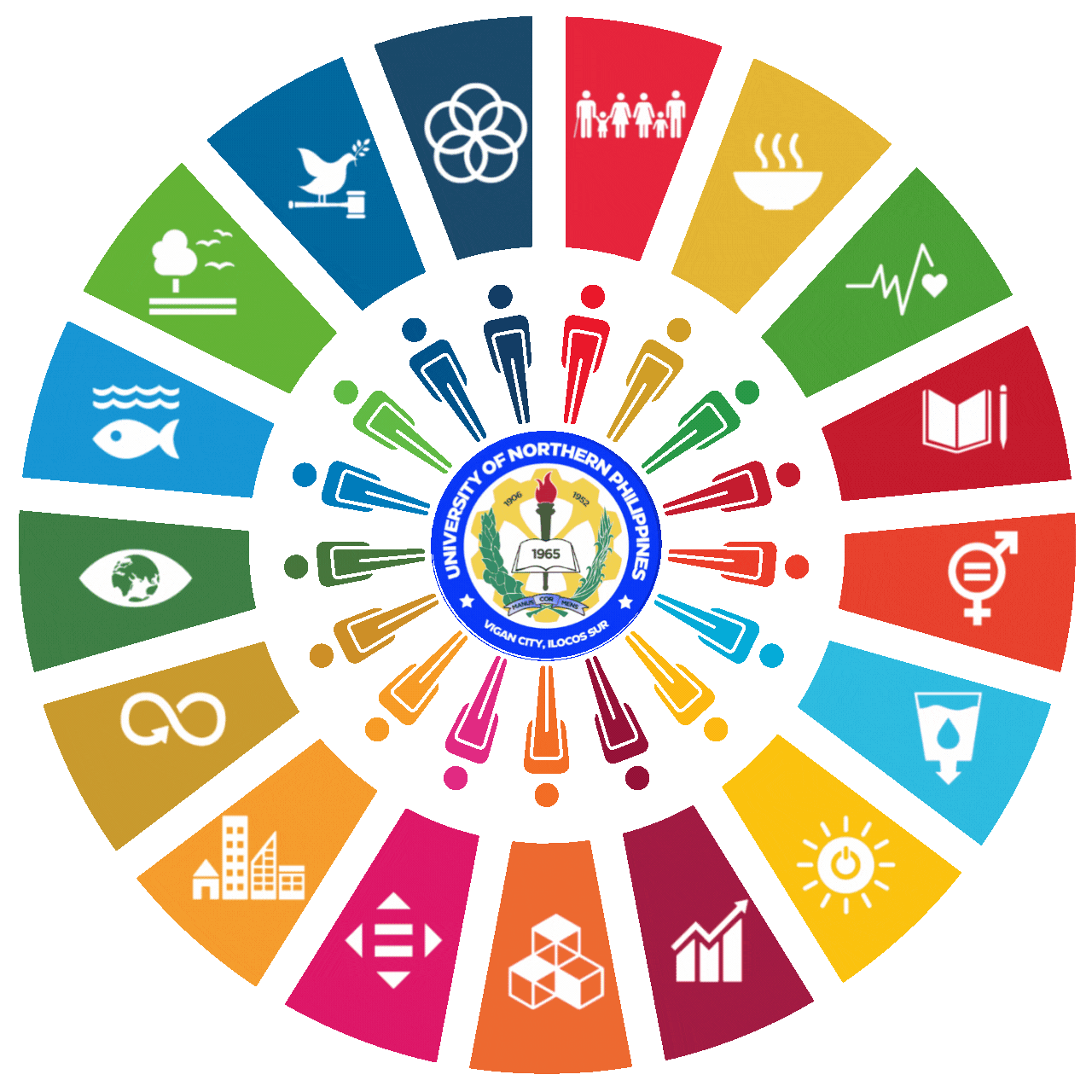

SDG 2 - ZERO HUNGER
The University of Northern Philippines (UNP) affirms a strong commitment to Sustainable Development Goal 2: Zero Hunger through various initiatives that align with the goal’s targets.
Proponents: Keran Tomson, Amrutha Thanku, Varada Gigi, Niranjana S. Kumar, Shaik Mohammad Ashwaq and Chris Paul P. Pagaoa
Abstract: Insects pose significant ecological threats and act as vectors for pathogenic microorganisms. In addition, insects damage crops, leading to substantial economic losses. Traditionally, chemical insecticides have been employed to manage insect populations; however, their detrimental effects on the environment and human health have raised concerns. The study evaluated the potential of Raphanus sativus as an alternative natural insecticide. Contact toxicity and mortality assays were used to evaluate the insecticidal efficacy of R. sativus leaf extract in varying concentrations against D. melanogaster larvae and adults. The insecticidal activity was assessed by measuring percentage mortality at three different time intervals (30, 45, and 60 minutes). Statistical analyses, including ANOVA and Scheffe's post-hoc tests, were conducted to identify significant differences between treatments. The findings demonstrated that R. sativus leaf extract exhibited insecticidal activity against D. melanogaster larvae after 45 and 60 minutes of exposure. The extract showed promising efficacy against adult D. melanogaster, with insecticidal activity comparable to the chemical insecticide malathion at all exposure times (30, 45, and 60 minutes). These results suggest that R. sativus leaf extract holds potential as an effective and environmentally safer alternative to chemical insecticides in pest management.
Keywords: insecticidal, contact toxicity, mortality test
Proponents: Clarence R. Renon, Odezza R. Bolor, Ronnielyn M. Castro, Ronaia Belle L. Rivera, Hendric James C. Ayon and Charo B. Rojas
Abstract: Hydroponic cultivation offers sustainable agricultural solutions, but the efficiency of water sources in hydroponic systems is underexplored. Understanding these sources is crucial for optimizing resource use, mitigating environmental impact, and ensuring long-term sustainability in hydroponic agriculture. This study aimed to assess the growth and yield performance of pechay (Brassica napus L.) var. Black Behi using hydroponic systems with different water sources: tap water (T1), unfiltered wastewater (T2), and filtered wastewater (T3). The research evaluated the sustainability of the CHRRO hydroponic system, which exclusively uses filtered wastewater (T3) for hydroponic cultivation. Using a Completely Randomized Design, 15 plants per treatment (T1, T2, and T3) were studied. The study measured growth parameters, including plant height, number of leaves, leaf width, and weight, and assessed the acceptability of the CHRRO hydroponic system in Bacsil, San Juan, Ilocos Sur, using standardized rating forms from experts in agriculture, science, electronics, and farming. Pechay plants in filtered wastewater (T3) exhibited superior growth and yield compared to those in tap water (T1) and unfiltered wastewater (T2). ANOVA confirmed significant differences (p < 0.05), with T3 being the most effective water source. The CHRRO system, utilizing filtered wastewater exclusively, received high acceptability ratings (mean rating: 4.56). However, Kendall's W indicated low agreement among experts (W= 0.133, p = 0.257), suggesting variability in evaluations due to differing expertise. The CHRRO system, which uses filtered wastewater, is ideal for hydroponic cultivation, and future research should include microbial analysis, nutrient profiling, economic and environmental assessments, continuous monitoring of water parameters, and expert feedback.
Keywords: Hydroponic, CHRRO hydroponic system, tap water, unfiltered wastewater, filtered wastewater
Proponents: Deborah Jaena R. Reoliquio Richel Royce T. Chan Gerald P. Valdez Kharl Patrick F. Partosan and Jesica P. Bayani
Abstract: This study aimed to develop tofu-banana peel dumplings and to determine the significant differences between fried dumplings (T0) and (T1) steamed dumplings in terms of appearance, taste, aroma, and texture. An experimental research design was used. A total of 50 respondents evaluated the developed product, comprising students and teaching personnel of the College of Business Administration and Accountancy. Weighted mean was used to analyze the data. Results of the study revealed that the fried dumpling (T0) mixtures were very much acceptable in terms of appearance, taste, aroma, and texture, while the steamed dumpling (T1) was very much acceptable. Significant differences existed between the acceptability of the two mixtures. Fried tofu-banana peel dumplings (T0) produced a better quality than the steamed tofu-banana peel dumplings (T1).
Keywords: product development, dumpling, experimental research
Proponents: Dea Meir Sebastian, Katrina Corpuz, Kasandra Nicole Erece, Kim Cherry Inot, Elyona Karis Laygo, Fate Janelle Perez, Frances Jane Ramos and Christian S. Domondon
Abstract: Despite the abundance of vegetable hummingbird (Sesbania grandiflora) flowers, locally known as Katuday/Katuray, they remain underutilized despite their potential as a sustainable food source. This research explored the feasibility of producing noodles from these flowers, branded as Katoodles (Katuday Noodles), to increase their utility and address wheat shortages. By examining the sensory characteristics of noodles made from vegetable hummingbird flowers and wheat flour, the study aimed to provide an innovative and sustainable food product. This quasi-experimental research used four ratios of blended vegetable hummingbird flowers to flour (0:100, 50:50, 60:40, and 40:60). Five food technology and cookery experts, along with five consumers, evaluated the Katoodles based on taste, texture, smell, and appearance using a Five-Point Hedonic Scale. Results indicated that noodles could successfully be made with these blends. Katoodles with 50% blended vegetable hummingbird flowers (Mixture 1) scored the highest in sensory evaluation, while commercial noodles (Mixture 0) scored the lowest. No significant difference was found among the Katoodles mixtures, suggesting consistent quality comparable to commercial products. This study highlights the broader potential of utilizing underutilized crops like Katuday/Katuray to promote sustainability and reduce reliance on wheat. Katoodles offers a nutritious, plant-based alternative, addressing the demand for healthier, eco-friendly options. Their commercialization could diversify the noodle market, create economic opportunities, and encourage the cultivation of sustainable crops. Further research on the nutritional value and marketability of Katoodles is recommended.
Keywords: Katoodles, mixtures, noodles, quasi-experimental, vegetable hummingbird flowers


















